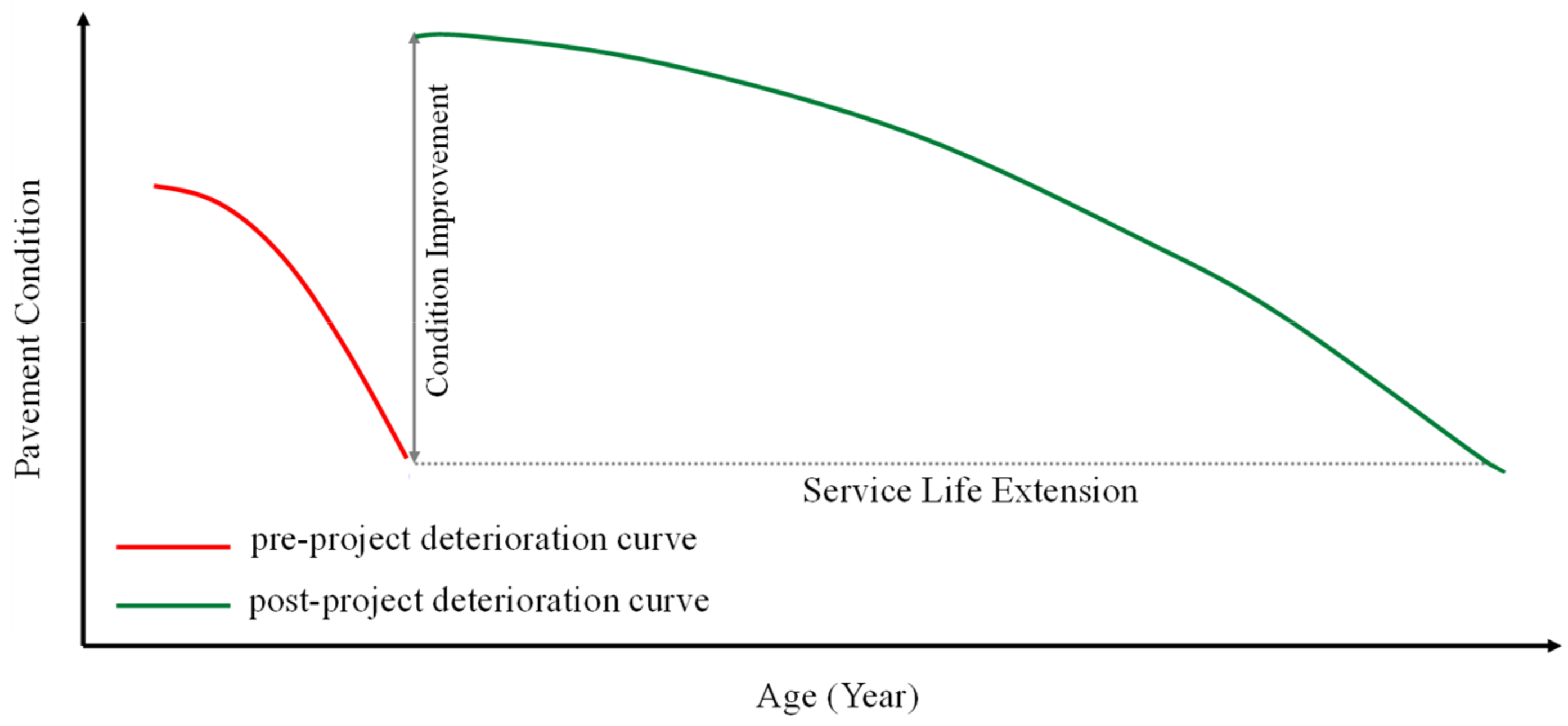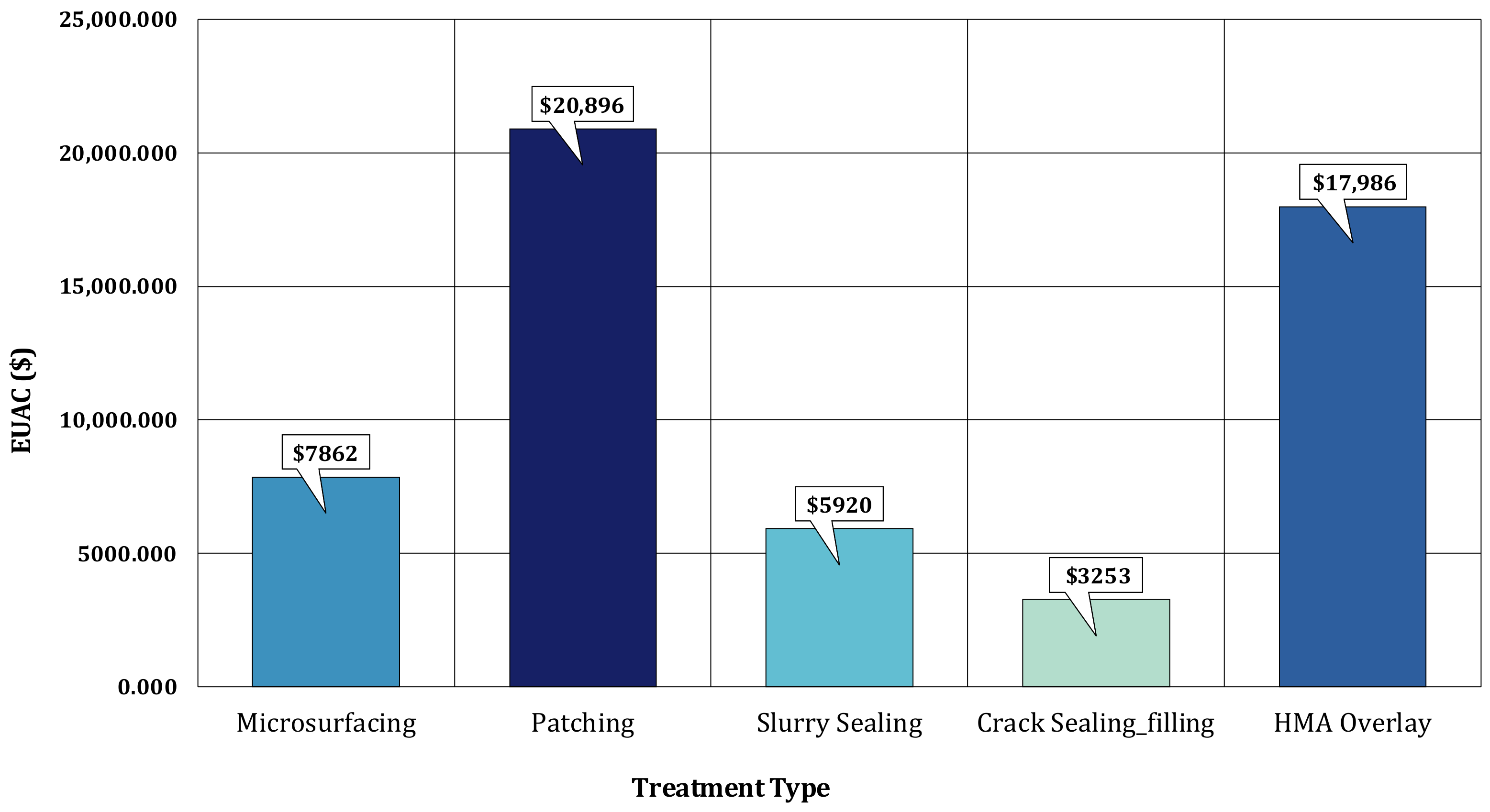1. Introduction
Pavement preservation involves proactive efforts to maintain existing pavements in a state of good repair. Unlike rehabilitation and reconstruction projects, pavement preservation methods aim to restore and prolong pavement serviceability rather than add structural capacity. Numerous benefits can be attributed to pavement preservation, including optimized use of scarce resources to improve safety, mobility, and user satisfaction. Engineering judgment is extensively involved in the current practices of pavement preservation decision-making; nevertheless, as the state transportation agencies move away from subjective decision-making toward more objective, data-driven approaches, the pavement preservation programs shall also move along.
The state DOTs can implement various preservation treatments based on pavement surface type, functional class, traffic loading, and the extent and severity of distresses. Today, many transportation agencies have developed decision-making tools, such as decision trees and application matrices, to assist in the timing and treatment selection of pavement preservation programs. These decision-making tools typically link preservation treatments to pavement distress types and severity levels based on decision factors such as service conditions, past repair and maintenance activities, expected treatment effectiveness, and the relative costs of the candidate treatments [
1,
2].
This research aims to develop an analytical foundation for data-driven pavement preservation strategies by evaluating the effectiveness of different preservation techniques relative to the road type and underlying conditions. The study leverages Iowa DOT’s pavement management information system (PMIS) data to model pavement performance and determine the influence of preservation treatments.
2. Data Sources and Description
This study’s primary data source was Iowa DOT’s pavement management information system (PMIS). Iowa DOT’s electronic records management system was also utilized to derive project location information when necessary. Project details and cost information were derived from Iowa DOT’s historical bid tabulations (2015 through 2023). The PMIS contains comprehensive road characteristics data for all state roads in Iowa. The collected data include detailed distress measurements, traffic information, and pavement history. Condition data in the PMIS include indexed metrics, such as the pavement condition index (PCI), the rutting index, the international roughness index (IRI), and the cracking index, and the measures of individual distress types, including alligator cracking, transverse cracking, longitudinal cracking, durability cracks, and joint spalling. The study used the performance data of 7255 PMIS road segments from 1998 through 2020.
3. Methodology and Analysis
The overall research methodology adopted in this study is described in the sections below.
3.1. Performance Modeling
The effectiveness of a pavement preservation treatment was evaluated by analyzing pavement performance before and after the particular treatment was implemented. Pavement performance was represented by the absolute values of condition indices and the index degradation rate. Obtaining these quantities enabled the quantification of the amount of pavement life extension by a given preservation project. Then, this life extension calculation was applied to all segments undergoing a given type of preservation treatment. This allowed for the determination of the expected (mean) life extension capability for that treatment method. Furthermore, analyzing life extension data against pavement and road characteristics, particularly the underlying pavement condition and traffic volume, provides insights into when and where the treatments are best implemented. The condition index used for the analysis was the PCI because it encompasses all of the important distress indices for flexible pavements. However, individual distress indices, i.e., the rutting index, riding index, and cracking index, will be considered in the next steps to establish a relationship between treatment effectiveness and individual distress. The treatment methods considered were microsurfacing, slurry seal, patching, crack sealing/filling, and hot mix asphalt (HMA) thin overlays. The Iowa DOT calculates the
based on Equation (1) [
3]:
where the cracking index is obtained from Equation (2):
where
is the transverse cracking index,
is the longitudinal cracking index,
is the longitudinal wheel path cracking index, and
is the alligator cracking index.
The service life extensions with respect to the
were then determined by solving the post-preservation deterioration curve function for the latest pre-preservation index value.
Figure 1 illustrates the improvement in the
and the pavement service life extension caused by pavement preservation treatment. The index benefits were defined as the area between the pre-project performance curve (i.e., the do-nothing scenario) and the post-project deterioration curve over the range of extended life; this value was used as an additional metric to evaluate the treatment effect with respect to a specific condition index. Note that the pre-project performance curve must be extrapolated onto the extended life range for this purpose.
In order to determine the average life extension for each treatment type, the results of each project segment were categorized according to the project type and averaged.
Table 1 indicates that slurry sealing could extend pavement life by about 2.5 years, which is the lowest of all possible treatments. The highest service life extension was provided by hot mix asphalt (HMA) thin overlays (less than 3 inches) with an average of almost nine years of extension.
3.2. Benefit–Cost Analysis
Using the service life extension and index benefits, the next step was a benefit-cost analysis. The life cycle cost analysis (LCCA) took two primary inputs for each distinct preservation treatment to determine their cost over the life cycle, namely, implementation cost and life extension. Implementation costs were calculated as shown in
Table 2 based on the bidding tabulation data. Life–cycle cost was represented by the equivalent uniform annual cost (
) which was obtained from Equation (3):
where the net present value (
) can be calculated from Equation (4).
where
is the year of expenditure and
i is the real discount rate according to the OMB Circular by the U.S. Government, (1.2 to 2%), and the analysis period was 10 and 20 years. Maintenance costs were capped at USD 2500 annually and calculated using Equation (5) based on a 5-year sliding scale.
Equation (6) can be used to calculate the salvage value, which represents the present value of any remaining service life:
The life cycle cost analysis (LCCA) results, for a 10-year analysis period and 1.5% discount rate, are summarized in
Figure 2. As the figure shows, crack/joint sealing demonstrated the lowest EUAC at USD 3253.160. Slurry sealing produced the next lowest value followed by microsurfacing, HMA thin overlay, and patching, with average EUAC values of USD 5920.129, USD 7861.798, USD 17,985.873, and USD 20,896.108, respectively.
4. Summary and Conclusions
This research pursued the development of a data-driven framework for objective decision-making about pavement preservation strategies. Through statistical performance modeling, the effectiveness of five pavement preservation methods, namely, microsurfacing, slurry sealing, patching, crack sealing/filling, and HMA thin overlay were determined in terms of pavement life extension and PCI index benefits. Then, the results were used in a simple economic analysis framework to evaluate the economic impact of each preservation method in terms of equivalent uniform annual cost (EUAC). The study found that HMA thin overlay resulted in the largest service life extension for the PCI, 8.93 years, while slurry sealing had the lowest service life extension, 2.54 years.
Author Contributions
Conceptualization, O.S. and A.S.; methodology, A.S., S.A. and O.S.; validation, A.S. and S.A.; formal analysis, A.S. and S.A.; investigation, A.S. and S.A.; resources, O.S.; data curation, A.S.; writing—original draft preparation, A.S. and S.A.; writing—review and editing, A.S., S.A. and O.S.; visualization, S.A. and A.S.; supervision, O.S. and A.S.; project administration, O.S.; funding acquisition, O.S. All authors have read and agreed to the published version of the manuscript.
Funding
This research was funded by Iowa Highway Research Board, Iowa Department of Transportation grant number 20-728, TR-784.
Institutional Review Board Statement
Not applicable.
Informed Consent Statement
Not applicable.
Data Availability Statement
The pavement data presented in this study are not publicly available. The data derived from Iowa DOT’s pavement management information system (PMIS) and Iowa DOT contracts portal and Bid Express® subscription service.
Conflicts of Interest
The authors declare no conflict of interest.
References
- Buss, A.; Claypool, B.; Bektas, F. Effectiveness of Pavement Preservation Techniques. 2019. Available online: https://intrans.iastate.edu/research/completed/effectiveness-of-pavement-preservation-techniques/ (accessed on 10 August 2023).
- Abdelaty, A.; Jeong, H.D.; Smadi, O.; Gransberg, D.D. Iowa Pavement Asset Management Decision-Making Framework. 2015. Available online: https://rosap.ntl.bts.gov/view/dot/29597 (accessed on 10 August 2023).
- Bektas, F.; Smadi, O.G.; Al-Zoubi, M. Pavement Management Performance Modeling: Evaluating the Existing PCI Equations. 2014. Available online: https://intrans.iastate.edu/research/completed/pavement-management-performance-modeling-evaluating-the-existing-pci-equations/ (accessed on 10 August 2023).
| Disclaimer/Publisher’s Note: The statements, opinions and data contained in all publications are solely those of the individual author(s) and contributor(s) and not of MDPI and/or the editor(s). MDPI and/or the editor(s) disclaim responsibility for any injury to people or property resulting from any ideas, methods, instructions or products referred to in the content. |
© 2023 by the authors. Licensee MDPI, Basel, Switzerland. This article is an open access article distributed under the terms and conditions of the Creative Commons Attribution (CC BY) license (https://creativecommons.org/licenses/by/4.0/).









